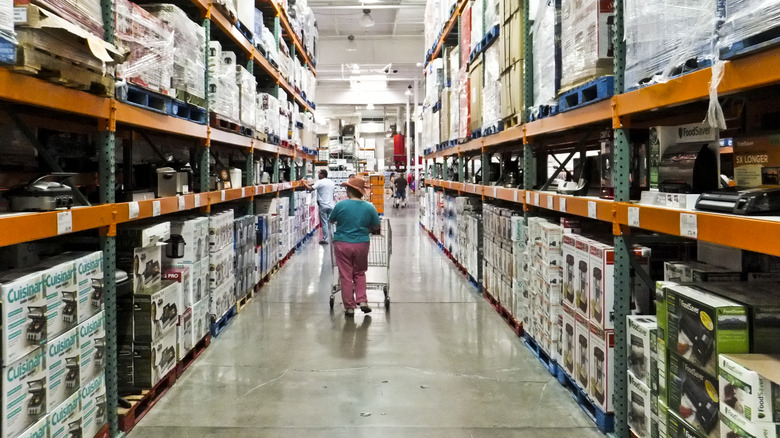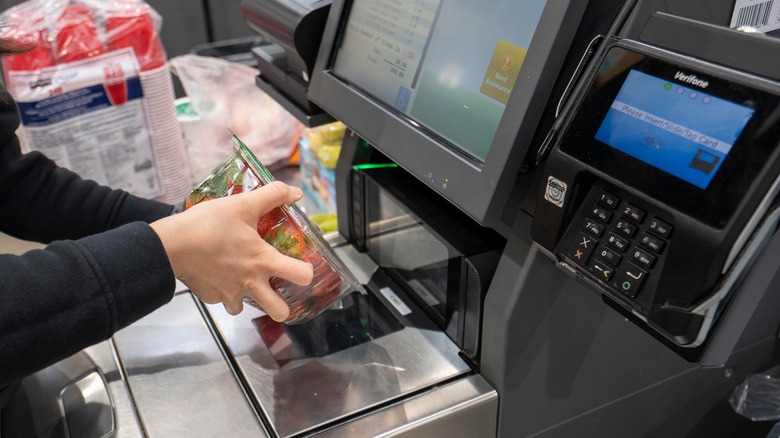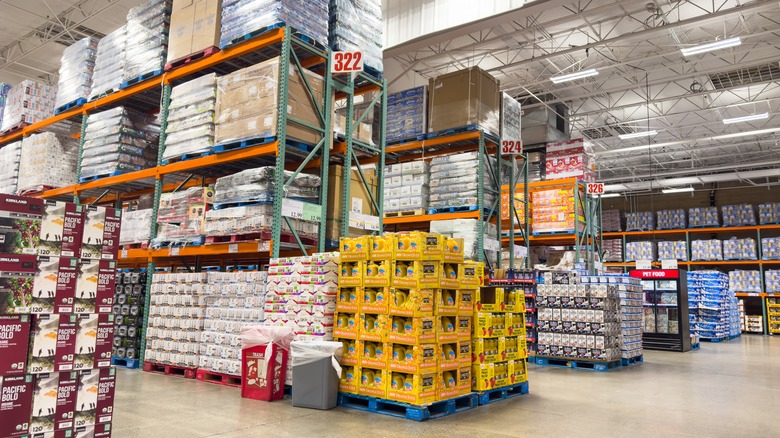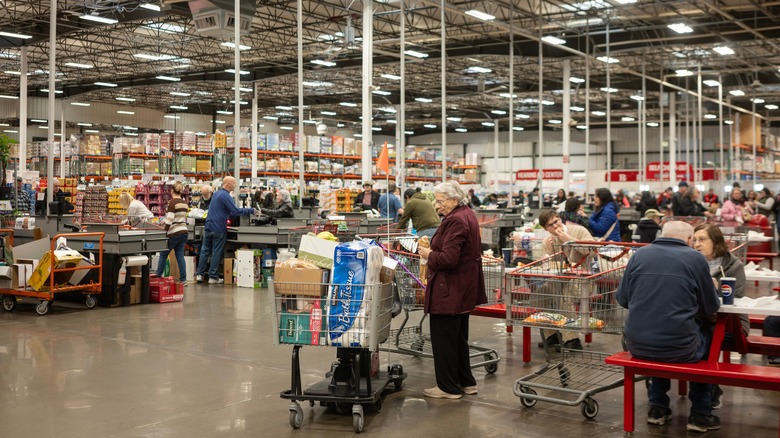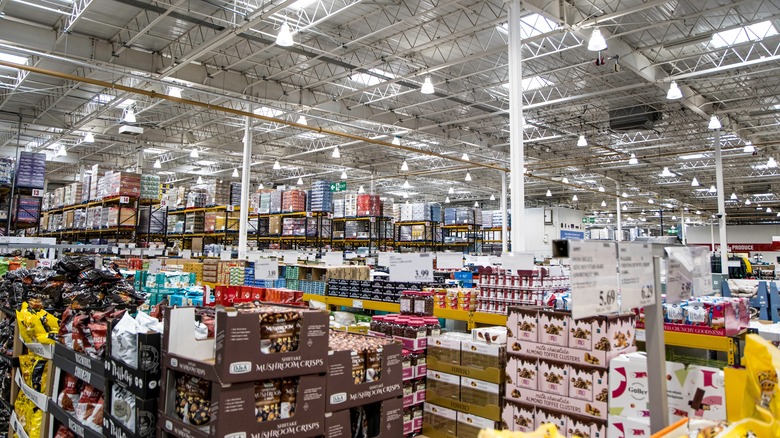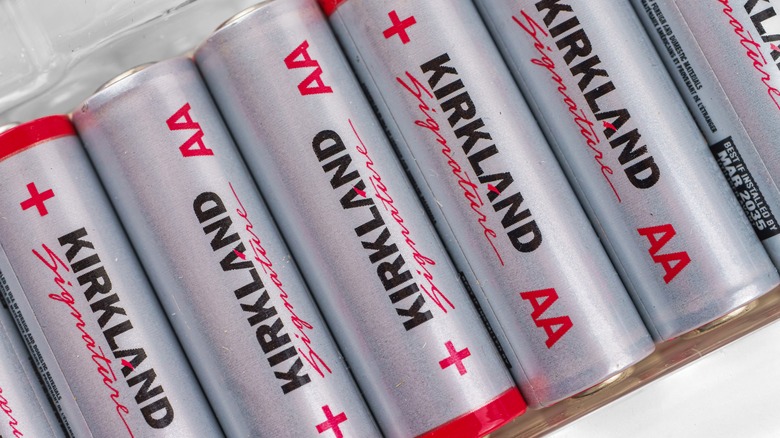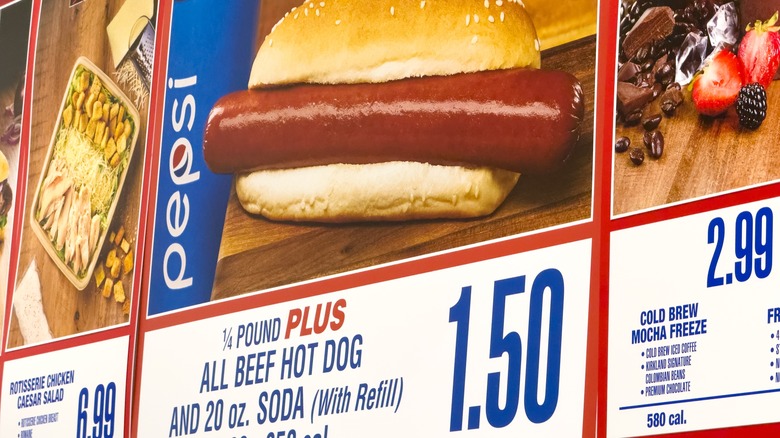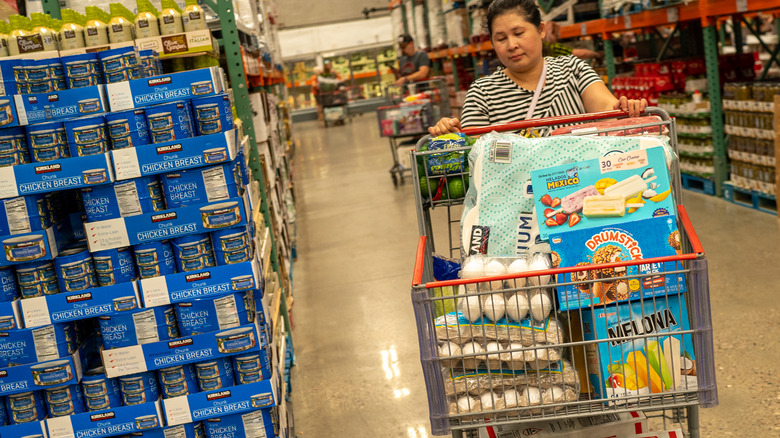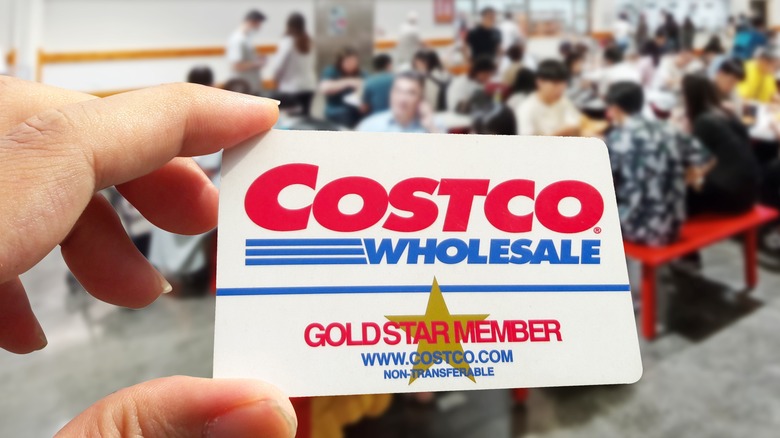This Is What It Was Like To Shop At The First Costco
It's hard to imagine a world without Costco, but that's the world we lived in back in 1982 (no Costco food court? It was a harder life back then). Costco's humble beginnings were in San Diego when a store called Price Club opened on Morena Boulevard in 1976. Price Club served local small businesses but quickly discovered its customer base extended beyond business owners. It began selling memberships, and the warehouse retailer industry was born.
Costco, as we know it, came soon after. Jim Sinegal, Price Club's executive vice president of merchandising, distribution, and marketing, teamed up with entrepreneur Jeff Brotman, and the rest, as they say, is history. The first Costco opened its doors in 1983 at 4th Avenue South in Seattle, Washington. Today, there are more than 800 Costcos worldwide.
Costco's popularity was immediate. Drawn to affordable pricing and an efficient shopping experience, customers made Costco the first retail store ever to achieve $3 billion in sales in less than 6 years. Today, Costco is a household name. The Costco community laments when Costco stops selling popular foods and gets excited when our favorite products go on sale (true Costco fans know what the asterisks on the price tag really mean). While many things have stayed the same in Costco's 40-plus years, some things have changed with the times. Here's what it was like to shop at the world's first Costco in the early '80s.
You had to pay with cash or check
If you were shopping at Costco in 1983, you could leave your credit cards at home — but you'd need to bring your checkbook. The original Costco only accepted cash or checks and was advertised as a wholesale cash and carry membership warehouse. That's quite a change from today as Costco offers its own branded credit card to members. It's unclear exactly why Costco required cash or check payment initially, but it's likely because the brand was trying to avoid credit card processing fees, and in turn kept prices low. Today, Costco's credit card is coveted by its customers for the generous cashback offers on Costco gas and purchases.
You don't need a Costco credit card to pay with credit at Costco, but you need the right card for the job. Costco only accepts Visa cards and has negotiated a contract with Visa where it pays just a .4% transaction fee. Typical transaction fees are between 1.3 to 3%. While Costco only uses the Visa credit card network today, you're not wrong if you have memories of paying with American Express. Costco had an exclusive agreement with American Express that lasted from 1999 until 2016.
If you forget your Visa or don't have a Costco card, don't worry — Costco doesn't want to turn away your money, and there are still many ways to pay. Costco accepts cash, checks, most debit cards, and mobile payments through platforms like Apple Pay.
Items cost no more than 9% over wholesale costs
Most people don't need a 4-pound jug of mayonnaise or industrial-sized boxes of cereal, but Costco knew from the beginning that savings come from buying in bulk. Costco enticed customers to embrace buying in bulk (saving lots of cash) by offering its products for just 9% over wholesale costs. We're not sure when Costco increased its markup caps, but today, Costco marks prices up about 14 to 15% (for comparison, it is common for a supermarket to mark products up by 25 to even 50%). Instead of marking up their inventory, Costco relies on memberships to help the business turn a profit.
Keeping the prices this low ensures that inventory is always moving. Quick turnover means Costco doesn't need to spend money on space to store surplus products — everything goes right onto the warehouse floor, and when it's gone, it's gone. If you see something at Costco that piques your interest, you'd better grab it while you can – the store chooses items that will sell fast and items that are there today might be gone tomorrow. From day one, customers could take advantage of Costco's unique shopping model and enjoy low prices due to the low markups.
The building was 100,000 square feet
The first Costco was 100,000 square feet, or over 2 acres. While that might seem huge (especially if you're pushing a big old Costco shopping cart around), it's smaller than most modern Costcos, which average 146,000 square feet (nearly 3.5 acres, in case you're wondering). But that's all small potatoes when compared to the world's largest Costco. The honor goes to a Salt Lake City store that clocks in at a whopping 235,000 square feet.
It looks like Salt Lake City won't hold the distinction for long, as a proposal was submitted in 2023 to build an even larger store in Fresno, California. If all goes as planned, the new store will be 241,000 square feet — large enough to hold four football fields. A store that size is certainly on-brand for the world's third-largest retailer, and we can't help but wonder what amazing Costco finds will grace its aisles.
You had 4,000 items to choose from
The first Costco stocked about 4,000 items, which has remained consistent throughout years of growth. Unlike many typical grocery stores today, which typically carry between 15 and 60 (yes, 60) thousand different items, Costco has always chosen to streamline its offerings to allow customers to focus on quality over quantity. The curated selection of SKUs (stock keeping units) means that every item in a Costco store undergoes a rigorous evaluation process based on the product's price, brand, and distinctive features to ensure it meets Costco's high standards for value and demand.
Costco's "less is more" approach has been an integral key to its ongoing success. It lets shoppers focus on quality and convenience rather than getting lost in the choices. You know you can get a loaf of bread (actually, make that two) at Costco, but the decision-making process won't weigh (or slow) you down.
The Kirkland Signature brand didn't exist
The Kirkland Signature brand didn't make an appearance until the mid-'90s, when Costco leadership decided they wanted to unify all of its private label brands (it had around 30 at the time) under one brand umbrella. Prior to Kirkland Signature, Costco had a variety of house brands, with names like Simply Soda and Chelsea toilet paper. While the 1983 store was devoid of the Kirkland brand, today, Kirkland Signature is a household name.
Named after the town Costco was originally headquartered in (Kirkland, Washington), Kirkland Signature was a way for Costco to establish consistency and brand recognition across its store-brand products, as well as provide consumers with an improved shopping experience (customers quickly learned they could trust the Kirkland Signature brand for quality and value). Costco applied the brand to everything from chocolate chips (later discontinued) to women's jeans, and Costco fans have been eating it up for decades. In the 2023 fiscal year, Kirkland Signature products produced $56 billion (with a "b") for the brand in revenue. Not too shabby!
There wasn't a pharmacy
Today, Costco's pharmacy is a huge draw to members and non-members alike, but shoppers in the early days would have had to pick up their prescriptions elsewhere – the Costco pharmacy didn't exist until 1986 when one opened in a Portland, Oregon store. Today, you need to have a membership to enjoy most of what Costco offers, but there are exceptions to the rule. Anyone can purchase prescription drugs at Costco's pharmacy — no membership required.
Compared to CVS and Walgreens, Costco offers significant savings on its prescription drugs (in some cases, up to 50%). Everyone can save big, but the convenience of using Costco's pharmacy is also important when shopping for prescriptions. Costco has a mail-order service and auto-refill program, and it will even fill prescriptions for your pets (just let your vet know you need a prescription and will be filling it at Costco the next time you pick up pet meds).
While you don't need a membership to take advantage of Costco's pharmacy, you'll save even more if you are a member. Costco rolled out a members-only program called Script Savings that provides members with even more incentives to bring their Rx to Costco (and again, it works for your four-legged friends, too).
You couldn't get a hot dog (at least, not the food court kind)
It's hard to imagine Costco without a food court, but the first food court didn't appear until 1985. The Costco hot dog had its humble beginnings in a hot dog cart outside of a San Diego Costco in 1984. The brand was Hebrew National, which was Costco's hot dog supplier at the time. The price for a hot dog and a drink inside the store in 1984? $1.50. And it's still $1.50 today – how are its hot dogs still $1.50? – almost 40 years later.
The hot dog used to be a way to entice non-members into the store, but in 2024, Costco put the kibosh on random hot dog shoppers and started requiring a Costco membership to purchase anything at the food court. And there's been further speculation around the quarter-pound hot dogs, including whether Costco will start delivering the meal.
While Costco's hot dog (and a drink!) price hasn't changed, the cost of manufacturing those hot dogs has. In 2008, Costco began operating its own hot dog manufacturing facilities to reduce costs. In recent years, there's been much buzz about hot dog prices and speculation that the price might go up, but in 2023, Costco's CFO Gary Millerchip said, "To clear up some recent media speculation, I also want to confirm the $1.50 hot dog price is safe" (via AZPM ). There was a collective sigh from Costco hot dog lovers around the nation.
The first Costco sold a plethora of items
From day one, Costco has provided consumers with a wide variety of goods all across the spectrum, from standard groceries to washing machines. An advertisement for the first Costco promised "dramatic savings" (via Kiro 7 ) on everything from calculators to candy to cigarettes (Costco has been phasing out the sale of cigarettes and tobacco, but you can still find them at some locations). Costco also sold alcohol from the very beginning, and in many states, you can purchase alcohol from Costco without a membership.
Some of Costco's early offerings are a sign of the times, a veritable 1980s time capsule about consumer tastes. For example, along with cigarettes, you could also purchase typewriters, watches, and microwaves (microwave sales were booming in the '80s). Today, you never know what you're going to get. Sometimes, Costco sells seemingly random items like saunas, caskets, and even bars of gold.
There were strict membership guidelines
Even from the beginning, Costco kept it exclusive. Not just anybody could be a Costco shopper – you had to be a card-carrying member of the Costco Wholesale Club to enter the "no frills" (Costco's words, not mine) warehouses. Costco initially offered two types of memberships: Wholesale (geared towards businesses and starting at $25) and Group Gold (starting at $30).
Membership prices have changed over the years, as have the options. Today, a Gold Star membership will set you back $65 a year. An Executive Membership, which comes with discounts on Costco services, costs $130 a year. Costco raised its membership dues for the first time in seven years in September 2024 ($5 and $10, respectively). While nobody likes a cost increase, Costco members didn't seem to balk. The wholesale club retailer enjoys a 93% renewal rate among its United States and Canadian members.
